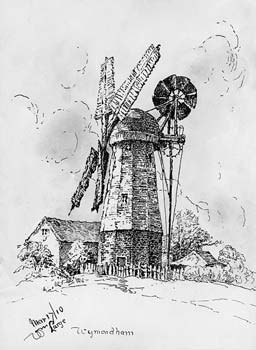
17th
March 1910
|
Wymondham
North Mill smockmill |
 |
|
17th
March 1910
|
| In
1858 Dilham_smockmill was dismantled
and moved to Wymondham via the Great Eastern Railway by Tom Brown and
his father. The cant posts were cut in two to allow them to be transported. Once there, according to the date stone over the doorway,
the mill was rebuilt as Northfield or North Mill for miller, farmer and corn merchant John Cann.
The structure was erected on a two storey brick base that was either built
in situ or remained from the previous mill on the site. Prior to moving to Dilham, the mill had been used as a drainage mill in Lincolnshire. The mill was erected at Northfields in Wymondham and became known as Wymondham North Mill and was the tallest smockmill in Norfolk. |
|
In the same year of 1858, John Cann's nearby small towermill was taken out of use and dismantled |
A stone was set over the door and inscribed: JOHN CANN OCT. 7 1858 Miss Mary Carter of Wymondham told Harry Apling on 18th October 1974 that the tablet was made from an old gravestone and on the back it bore the inscription in memory of ... REYNOLDS. |
Unusually, quite a lot of technical information for this mill has survived and is listed below, although there has been some conflicting data on occasions. |
While at Dilham, the mill was shown on the Bryant's map of 1826 and was working in conjunction with the nearby Dilham_watermill. It would appear that the mill was sold and moved to Wymondham when the tenant miller at Dilham, William Drake Gardiner, put his business assets up for auction, which in turn means that the following listing for Dilham was probably erroneous: Craven's directory 1858: William Drake Gardiner, also smock mill at Wymondham |
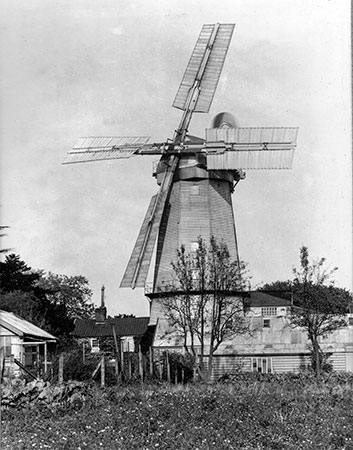 |
c.1926 |
The following advert appeared the week before the advert for the sale of William Gardiner's assets at Dilham and it is not clear whether it relates to John Cann's previous mill on his Wymondham site or the machinery from the mill at Dilham. |
To Millers To Be Sold (A BARGAIN) |
Nearly all the entire MACHINERY AND GOING GEARS of a TOWER WINDMILL comprising sails, 3 pairs of stones, spur wheel 8 feet diameter fine pitch, windshaft cast iron, winding tackle complete etc. etc., most of which are nearly new or equal thereto. Apply to Mr. John Cann, Wymondham Norfolk Chronicle - 18th September 1858 |
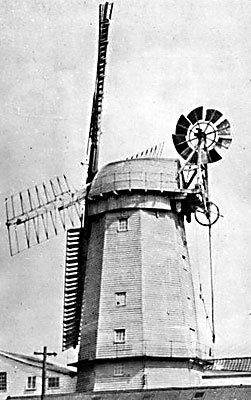 |
c.1930 |
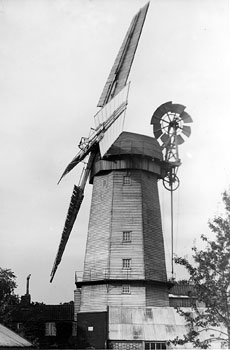 |
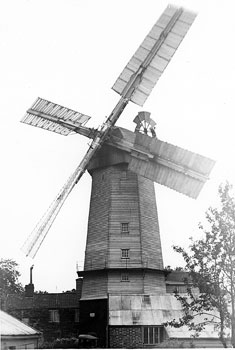 |
|
1931
|
|
|
The
mill was a seven storey, eight sided mill that stood 65 feet high and 62
feet to the gallery. It had a boat shaped cap with a petticoat on a dead
curb with 9 small centering wheels and an 8 bladed fan. The stage was on
the third floor. |
|
The
sails had a span of 80 feet; the outer pair having 8 bays of 3 shutters
and the inner pair having 7 bays of 3 shutters and 1 bay of 2 shutters
(outermost) with 5 on innermost on trailing edge (sic). Striking was by
rack and pinion and a chain pole. Some or all of the shutters were removed
c.1935. |
|
In
1927 new stocks were fitted made from Oregon pine. These were 67ft 4ins
long, tapering from 13½ ins to 7¼ ins square. These were fitted by
Cecil Thompson of Hardwick. |
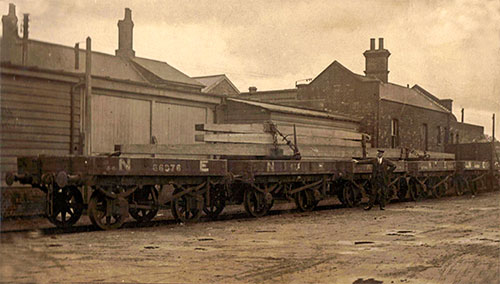 |
New stocks in Wymondham station sidings - 1927 |
|
The
whips were 31 feet long tapering from 12" x 11" to 12"
x 6". The iron windshaft was slightly tapering and the brake wheel
was made of wood with a clasp arm, was 11 ft. diameter and iron segmented
with cogs. The brake itself was 8" wide by 9" thick and was
very heavy. |
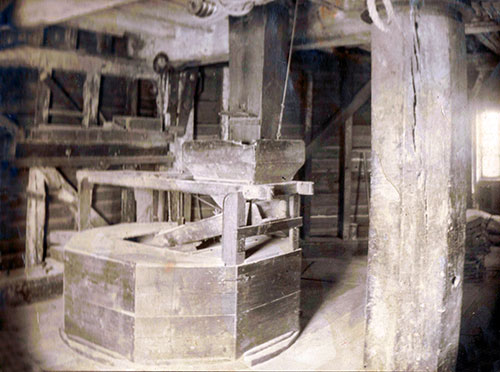 |
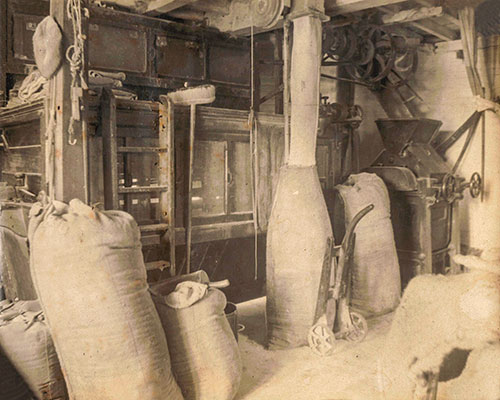 |
Stone tun - c.1927 |
Sack floor - c.1927 |
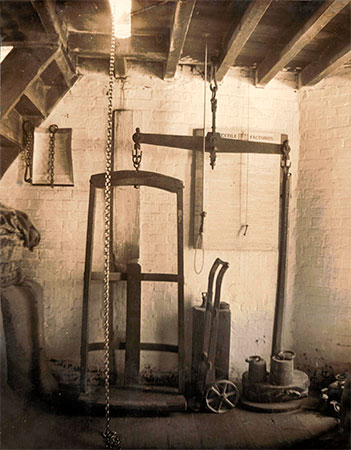 |
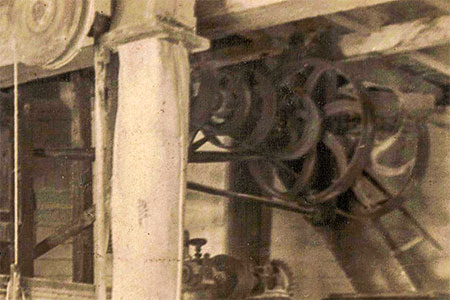 |
Sack scales c.1927 |
Belt pulleys from above photograph |
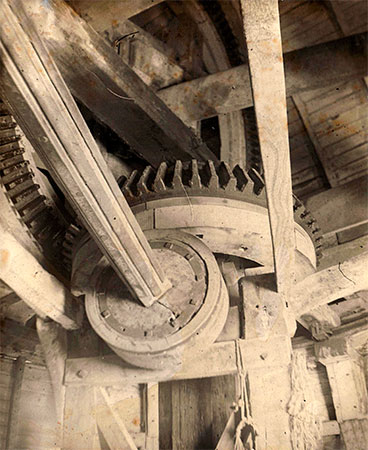 |
Cap interior - c.1927 |
|
The above photograph shows the cap interior, The brakewheel is mounted on the cast iron windshaft and is meshed to drive the wallower, mounted on the top of the centre post. A wooden pulley shaft with its pulley is set to run horizontally in the foreground. |
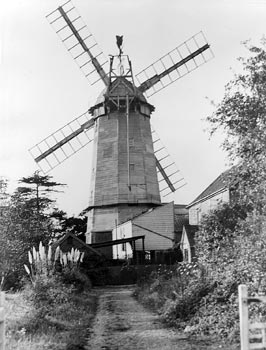 |
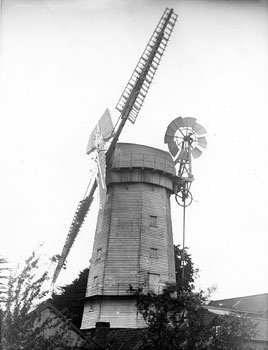 |
|
1931
|
|
|
Ground
floor: Here the walls were 2 feet 9 inches thick and the base had a diameter of 22 feet. 1st floor: This floor was within the brick base. It contained a centrifugal flour mill, a Booths cereal cutter and 2 additional pairs of stones driven by a 35 h.p. Crossley oil engine (1927). The loading door was also on this floor. 2nd or meal floor: Here the oak upright shaft was 20" square. The flour milling machine was positioned to take flour from the stones above. 3rd floor: Oak upright shaft with the great spur wheel that was 10' in diameter and made of wood. It had a clasp arm. iron segments with applewood cogs. The great spur wheel drove the three 17" iron stone nuts on 2¾" spindles with round tapers and a ring jack lift. A fourth pinion drove down to the Booth's Cereal Cutter. All of this machinery was boxed in for safety. The governors were of the heavy 4-ball type driven via a belt from a ring on the upright shaft a foot below the great spur wheel. This floor had a door leading out to the stage. 4th or stone floor: Originally this floor had three pairs of stones but by 1927 there were only two pairs of underdriven 4' 4" French burr stones within octagonal tuns and by 1948 there was only one pair and no tun. Here the upright shaft was apparently an 18" square or octagonal section of oak. 5th or corn / bin floor: Corn storage 6th or dust floor: The upright shaft had a section of pine 15" in diameter and the octagonal wallower had an iron casting that was 5' in diameter. The sack hoist was powered by a wooden drum 21" x 7½" using a friction drive against a wooden ring underneath the wallower. |
|
The mill also ran a Tattersall half-sack roller plant from 1949 that was probably also powered by the Crossley engine. |
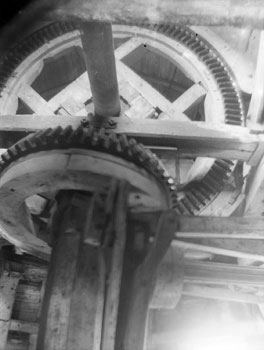 |
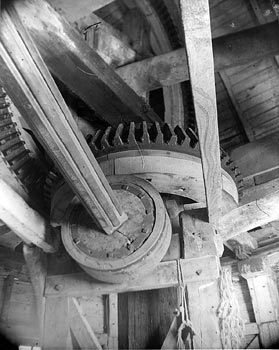 |
Brakewheel & wallower 1931 |
Wallower & sackhoist 1931 |
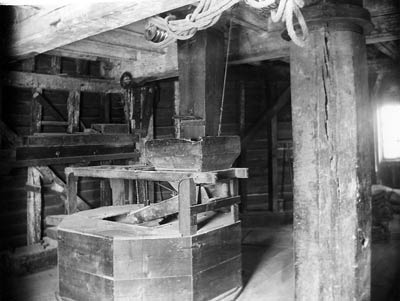 |
|
Tun
on the left and upright shaft on the right 1931
|
|
Situations Vacant WANTED, an experienced MILLER. Apply to John Cann, Wymondham or at his stand No. 107 in the Corn Hall, Norwich. Norfolk News - 6th October 1866 |
|
Situations Vacant WANTED, a steady active Man as CARTER and to assist in MILL as Grinder. A married man without family would be preferred. Apply to Mr. J. Cann, Wymondham or at No. 107 Stand in the Corn Exchange, Norwich. Norfolk News - 20th October & 24th November 1866 |
|
Notice to Debtors & Creditors of John Cann, deceased, late of Wymondham, who died 29th March last. Norfolk Chronicle - 13th May 1882 |
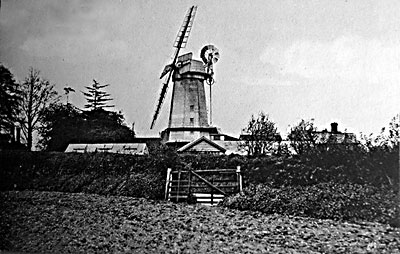 |
|
|
1934 |
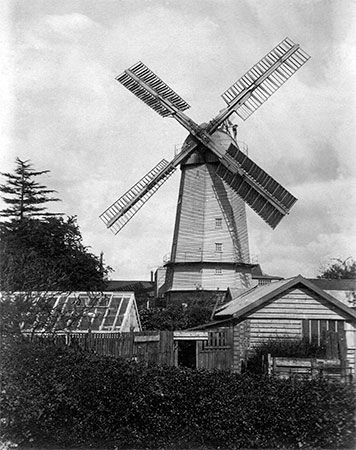 |
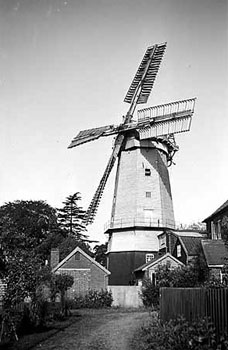 |
|
September 1934 |
September 1934 |
Wymondham North Mill Inspected 8th June 1948 |
According to Mr. Farrow was a marsh mill, brought from Dilham 1858. Tom Brown and his father moved it. Cut all corner posts and bolted when re-erected. Present stocks were put on about 1928, by Thompson of Alford. The shutters were taken out by Mr. Farrow before 1939 war. Mr. King had the mill when Mr. Farrow went there in 1908. Farrow became the owner when King retired in 1935 and went to Yarmouth, and worked mill as its owner until 1945 when sold to F. W. Myhill & Son, corn merchants, of Wymondham, who still have it Clasp-arm brake-wheel 11ft. diameter comprising four sets of arms with circular segmented rim. Geared with iron and wedged to shaft with wood. brake is wood, windshaft iron, slightly tapering. Wallower is 5ft. with iron arms and wood rim, iron geared, and is a very heavy wheel. 15in. octagonal wood upright shaft. Sack hoist is a 21 in. by 7½ in. wood drum friction driven against wood ring beneath wallower. Cap is very roomy, with 9 small centering wheels, the curb is dead. First floor down is bins, second down is empty except for a pair of stones without case. Third floor has a spur boxed in with upright shaft on baulk of timber 1ft. 9in. square. Spur is clasp-arm with wood teeth. Stone nuts are 17in. iron with 2¾in. spindles, round tapers and jack ring lift. Governors are heavy, of four-ball type with a belt drive of a ring on base of shaft 1ft. below spur. A nut engaging the spur is on a shaft to floor below for engine drive. Three pairs of stones. A fourth nut drives a Booths Cereal Cutter. Five wood and two brick floors. A tablet in the latter reads "John Cann, Oct'r. 7th. 1858". Mr. Myhill says mill stood in North Lincolnshire prior to Dilham, but Mr. Farrow has never heard so, and it seems doubtful if it did, for it is of typical Norfolk build, and with so many drainage mills in Norfolk it is hardly likely one would be brought from so far. Mr. King 1935 or 1936. Fan was blown off. Mr. Farrow worked 30 years. Mill used to have 3 pairs of stones, but only 2 in Mr. Farrow's time. Report supplied by H. E. S. Simmons, Shoreham by Sea, Sussex - October 1973 |
|
MILLING AND WINDMILLS. The Browick mill, so active when Jethro Garrett was the miller, ceased its milling operations long before its sails were blown away by a gale in 1825, and Henry Jermyn's mill in Silfield went out of action about thirty-eight years ago. The Northfield mill is the only windmill left with its sails, but these no longer rotate, the milling machinery being driven by an oil-engine installed about twenty years ago. We are indebted to Mr. C. Elliott of Beccles, for the following interesting details about the history of this old mill. "The smock mill at Wymondham ... was first erected in Lincolnshire, then removed to Ludham, * Norfolk, and in October, 1858, amid great celebrations, was transported by the old Eastern Counties Railway to Wymondham, where it now stands on a hill overlooking the town. The guiding hand in this enterprising move was John Cann, local squire, miller, brewer and wool-merchant. As it was found that trees near by deprived the mill of its source of motive power, the carcass or body was raised another fourteen feet, and so this windmill became the tallest in the county. ** Since 1939 the sails have not turned, and in the gales of two winters ago, the fan-tail took flight." Wymondham Old & New, J. E. G. Mosby & P. E. Agar - 1949 * Mill actually moved from Dilham not Ludham ** Tallest smockmill in Norfolk - Sutton towermill was taller |
William Farrow had been employed at the mill since 1908 and when Alfred King retired and went to Yarmouth in 1935, William bought the mill. William's nephew, Walter Farrow who had been at Wicklewood High St towermill and Silfield towermill worked North Mill whilst William Farrow managed the business. |
|
FIRE DESTROYS TOWER MILL
END OF LANDMARK AT WYMONDHAM |
Wymondham Mill one of the last tower mills at work in Norfolk grinding
corn, crashed to the ground yesterday half an hour after a fire had been
discovered at the base. The wooden structure fell on to an adjoining granary
containing hundreds of tons of corn feeding stuffs. The granary was soon well alight and was gutted. Most of its contents are believed to have been destroyed. It is thought the fire started in the engine room of the mill. Before long flames had spread above the two-storey brick base to the five timber storeys above. The area around was thick with flames and smoke. A considerable quantity of crude oil caught alight and burning slowly, added to the dense smoke. When the flames reached up to the sails they gave a last half turn before dropping into the burning mass of the mill below. HOUSES NEAR There were houses and a new office building close by. Although the flames were under control by 10 a.m. it was stated last night that firemen would be on duty until daybreak today damping down. Two appliances from Wymondham Fire Brigade, two from Attleborough and one from Norwich were quickly at the scene, Station Officer Cullum of Wymondham being in charge of operations. The Chief Fire Officer of Norfolk (Mr. Collow) was also present. Sub-Officer W. Howlett of the Wymondham Brigade cut his foot on glass and had to receive remedial attention. Prompt work by the firemen who doused the Baptist Church House with water saved this building - only about ten feet away from the mill. Windows were cracked and paint blistered by the heat. The water supply of Wymondham was seriously affected by the fire fighting operations. Half of the town was on very low pressure and the houses in the near vicinity were practically without water. The owners of the mill are F. W. Myhill & Son and the mill is at present under the control of Mr. Peter Myhill of Ashwellthorpe. (He was away collecting a load of oats from Inverness. H.A.) SMOCK TOWER Living in retirement in a house just across the road is Mr. W. Farrow, who ran the mill for 27 years, owning it for the last ten of these. He told a reporter that it was a smock tower mill and had been run by the sails up to about fourteen years ago. After his retirement the mill was converted to work by machinery and the sails, though still in existence were fixed. The stone part of the mill bears a stone showing it to have been erected at Wymondham by John Cann in 1858. Mr. Farrow says that it was brought to Wymondham from Dilham and reassembled. It had previously been a marsh pumping mill in Lincolnshire and was well over a hundred years old. "It was a big powerful old mill and did a lot of work as it had to in my early days to earn a living with the charge only a shilling a coomb for grinding, fetching and carrying", he said. It is not only Wymondham people who will miss their landmark - the last remaining of three in Wymondham at one time. Standing on the high ground and painted white, it will be missed by many motorists. Eastern Daily Press - Saturday 18th February 1950 |
In 1984 Harry Apling recorded that one 4 ft. French burr bedstone from the mill was in Wymondham Heritage Museum. |
|
My great, great grandfather, Henry King, bought a smock (wind) mill, of which I have an illustration, which was known as North Mill, Wymondham. Later his son Alfred developed the timber steam sawing business into a furniture factory, which I visited in the 1950/60s and which by this time was run by Henry Thomas King. This was sited alongside the rail line and had its own siding (thus known as Railway Works); if the two are the same, he must have sold the smock mill, as it was only lost in a fire on 17th Feb. 1950. The notes on the back of the illustration say that it was first erected in Lincolnshire, then moved to Ludham (11 miles NE of Norwich) and in October 1858 it was transported to Wymondham (7 miles SW of Norwich) by the Great Eastern Railway. The guiding hand was John Cann, miller, brewer and wood merchant. As nearby trees were a problem, it was raised by 14 feet and so became the tallest example in the county. Mike King - November 2004 N.B. Mill actually moved from Dilham not Ludham |
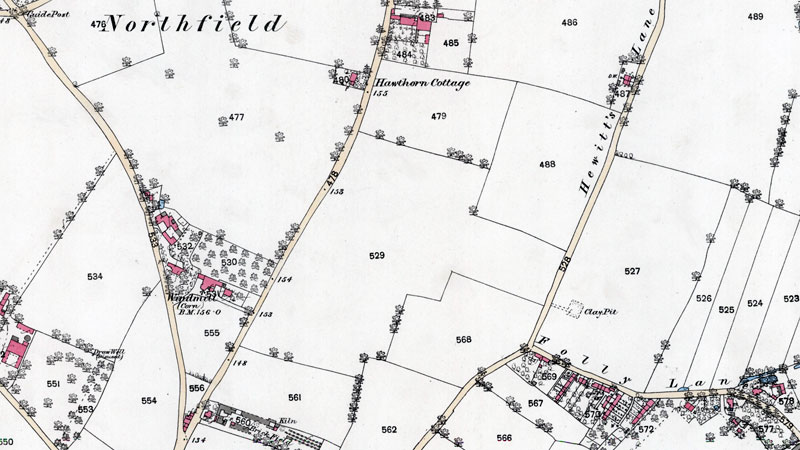 |
|
O. S. Map 1882 Courtesy of NLS map images |
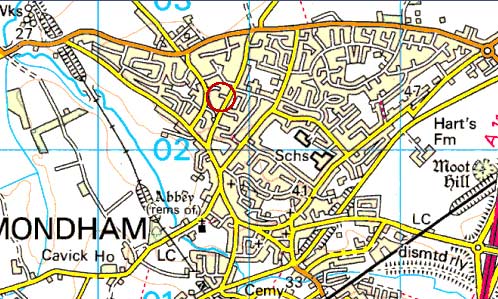 |
O.S. Map 2005 Image reproduced under licence from Ordnance Survey |
White's 1864: Cann & Clarke, brewers, maltsters, and wine, spirit & coal merchts. Market pl White's 1864: Robert William Cann, Esq. J.P., D.L., & Wm., brewers (Cann & Clarke), Cavick House White's 1864: Mrs. Emily Cann, Market pl Kelly's 1879: William Cann & Co. brewers, maltsters & wine & spirit merchants, Market pl Kelly's 1879: Frederick Freshfield Cann, farmer, Downham Kelly's 1879: Thomas Frederick Cann, farmer, Downham Kelly's 1879: Thomas William Cann, pork butcher, Market place White' s1883: Mrs. Emily Jane Cann, Market place
White's 1883: Mr. William Cann, The Elms, Norwich road
|
|
7th
October 1858:
Mill built for John Cann, miller, brewer & merchant, having been moved
from Dilham
1863: John Cann, miller 1864: John Cann, miller 1865: John Cann, miller 1866: John Cann, miller 1868: John Cann, miller 1872: John Cann, miller 1875: John Cann, miller 1878: John Cann, miller Kelly's 1879: John Cann, farmer & miller, Town grn 29th March 1882: John Cann died White's 1883: Henry King, miller, North mill O.S. map 1887: Windmill 1888: Henry King, miller White's 1890: Alfred King, miller, Northfield Mill White's 1890: Henry King, miller & corn merchant, Northfield mill Kelly's 1892: Henry King & Son, millers (wind & steam) & steam sawyers, North mill Kelly's 1896: Henry King & Son, millers (wind & steam) & steam sawyers, North mill Kelly's 1900: Alfred King, miller (wind & steam) & steam sawyer, North mill Kelly's 1904: Alfred King, miller (wind & steam) timber dealer & steam sawyer, North mill Kelly's 1908: Alfred King, miller (wind & steam) timber dealer, steam sawyer & wheelwright, North mill 1908: William Farrow started working at the mill
Kelly's 1922: Alfred King, miller (wind & steam), North mill Kelly's 1925: Alfred King, miller (wind & steam), North mill 1928: New stocks fitted by Cecil Thompson, millwright of Hardwick Kelly's 1929: Walter Farrow, miller (wind & steam), North mill c.1930: Oil engine installed 1933: Walter Farrow, miller Karl Wood painting 1933: Mill in use 1935: William Farrow bought the mill as Alfred King retired c.1936: Shutters removed and sails fixed Kelly's 1937: F. W. Myhill & Son, cake, manure & seed merchants, Northfield mills TN 129 1945: Mill sold to F.W. Myhill & Son, corn, cake, manure and seed merchants O.S. map 1946: Windmill c.1957: Fantail blown off 1949: Tattersall half sack roller plant installed in otherwise derelict mill Friday 17th February 1950: Mill burnt down due to fire starting in the engine room 1970: Mill site incorporated into Howlett's shoe factory |
If you have any memories, anecdotes or photos please let us know and we may be able to use them to update the site. By all means telephone 07836 675369 or
|
| Nat Grid Ref TG 10780232 |
Copyright © Jonathan Neville 2004 |